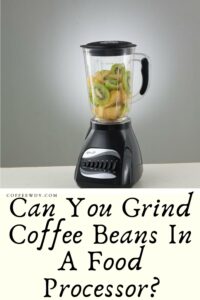Can You Grind Coffee Beans In A Food Processor?

Has there ever been a morning ritual practiced more profoundly, than the consumption of caffeinated gold? Coffee! In the minds of many, trumps work, marriage and even the children before 7 am.
Let’s face it. Coping with our daily routine without that hot, roasted, aromatic liquid bliss, is less desirable than listening to nails dragged across a chalkboard on a ten hour loop.
With our minds narrowed in on merely getting our coffee. One thing we can consider investing more time in, is how we prepare it. Coffee has become such a necessity, that we build temples and shines to worship it. Everyday, priests and priestesses, or as we will refer to them “baristas,” tend to their flock. People all around the world converge on these temples they call Cafés, all only too eager to pay homage and receive their fill.
When we find that perfect cup, we return time and time again, and wonder in awe how they achieve such a rich and velvety palate pleasing taste. Then we ponder how we can mimic such comforting outcomes on our own.
Let’s Discuss The Grind
A handful of factors dance together to deliver a delicious cup of coffee. However, today we will discuss “The Grind.”
If beans aren’t ground properly, it can affect the taste of your beverage. Too course, and your drink can be weak. Too fine, and it can become bitter and otherwise ruin that small opportunity to start the day on a positive note. And so, we rely on good coffee grinders to provide us with our chestnut coloured granules that we hold so sacred.
But, what if we don’t have a grinder? Is there an alternative that are common in the everyday household?
Can You Grind Coffee Beans In A Food Processor?
The answer is “YES.” Most food processors are acceptable for grinding coffee beans. Better yet, smaller options are easier to store. And should you need to take one to work with you; are more portable and won’t take up too much space in the lunchroom.
How To Grind In A Food Processor:
Grinding your own coffee comes with some pleasant benefits. Freshly ground beans can present stronger scents, and avoid that stale taste that comes with ageing coffee. Furthermore, using a food processor to grind, gives you control over the desired density. With a little experimenting, you will be able to determine the correct grain size for brewing.
Before using a food processor to grind. Make sure it is suitable. Most processors with a blade are appropriate. One important thing to keep in mind, is that you will need a processor that has a pulse button. This will allow you to blitz in short bursts without having to turn the processor on and off continuously.
Time To Grind
Now it’s time to get those blades spinning. Only add the amount you intend to brew. For example: if you’re making two cups, add 3.5 to 4 tablespoons of beans. This gives the blades room to move and avoids excess.
Use short pushes on the pulse button. Short pulses will blitz the coffee, but prevent it from forming on the sides of the processor. Make sure not to blend too often, as this will cause friction, that can alter the final taste. Portable processors are handy because they allow you to gently shake while blending, resulting in a more even blend. A medium to fine grain is considered a good start ( it will resemble sand). Medium ground coffee is great for Pour over, Drip and Siphon brewing methods. Courser grinds are suitable for French press and Cold brew, and finer grain for Moka and Turkish pots.
The Final Sip
From here, you can experiment with some of the other factors in your search for the holy grail of coffee enlightenment. Clean equipment, fresh pure water and quality coffee beans will all see you enjoying your espressos, macchiatos and cappuccinos in no time. Soon enough, you may even have your own little temple dedicated to freshly brewed heaven.
